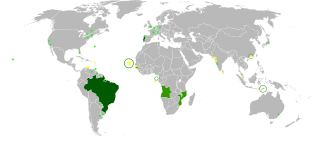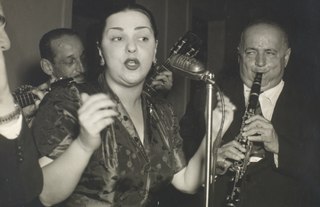
Samba, is a name or prefix used for several rhythmic variants, such as samba urbano carioca, samba de roda, recognized as part of the Intangible Cultural Heritage of Humanity by UNESCO, amongst many other forms of Samba, mostly originated in the Rio de Janeiro and Bahia States. Samba is a broad term for many of the rhythms that compose the better known Brazilian music genres that originated in the Afro-Brazilian communities of Bahia in the late 19th century and early 20th century, having continued its development on the communities of Rio de Janeiro in the early 20th century. Having its roots in the Afro-Brazilian Candomblé, as well as other Afro-Brazilian and Indigenous folk traditions, such as the traditional Samba de Caboclo, it is considered one of the most important cultural phenomena in Brazil and one of the country's symbols. Present in the Portuguese language at least since the 19th century, the word "samba" was originally used to designate a "popular dance". Over time, its meaning has been extended to a "batuque-like circle dance", a dance style, and also to a "music genre". This process of establishing itself as a musical genre began in the 1910s and it had its inaugural landmark in the song "Pelo Telefone", launched in 1917. Despite being identified by its creators, the public, and the Brazilian music industry as "samba", this pioneering style was much more connected from the rhythmic and instrumental point of view to maxixe than to samba itself.
Bossa nova is a relaxed style of samba developed in the late 1950s and early 1960s in Rio de Janeiro, Brazil. It is mainly characterized by a "different beat" that altered the harmonies with the introduction of unconventional chords and an innovative syncopation of traditional samba from a single rhythmic division. The "bossa nova beat" is characteristic of a samba style and not of an autonomous genre. The bossa nova wave became popular around the world and it helped to renew samba and to contribute to the modernization of Brazilian music.

The culture of Brazil is primarily of Western extraction, being derived from Portuguese culture, as well as the cultural mixing that occurred between the Indigenous peoples, Portuguese colonizers and Africans primarily during the brazilian colonial period. In the late 19th and early 20th centuries, Brazil received a significant number of immigrants, primarily of Portuguese,Italian and Spanish origin, which along with smaller numbers of Germans, Austrians, Arabs, Japanese, Poles and Ukrainians gave a relevant contribution to the formation of regional cultures in Brazil, and thus contributed to its current existence as a plural and racially diverse society.

Milton Nascimento, also known as Bituca, is a Brazilian singer-songwriter and multi-instrumentalist.
Samba is a lively dance of Afro-Brazilian origin in 2/4(2 by 4) time danced to samba music.

Lundu is a style of Afro-Brazilian music and dance with its origins in the African Bantu and Portuguese people.

Lusophones are peoples that speak Portuguese as a native or as common second language and nations where Portuguese features prominently in society. Is a group of Portuguese-speaking nations that share cultural or historical ties with the Portugal, and which today maintain close political, diplomatic and military co-operation. Comprising an estimated 300 million people spread across 10 sovereign countries and territories, thus called Lusofonia or the Lusophone world, is the community of Portuguese-speaking (Lusophone) world; these include Angola, Brazil, Cape Verde, Galicia, Guinea Bissau, Equatorial Guinea, Macau, Mozambique, Portugal, São Tomé and Príncipe, East Timor, Uruguay, Cochin, Azores, Madeira, Goa, Daman and Diu, Singapore and Malacca to various degrees.

In capoeira, music sets the rhythm, the style of play, and the energy of a game. In its most traditional setting, there are three main styles of song that weave together the structure of the capoeira roda. The roda represents the most strict and traditional format for capoeira and is ideally suited for an introduction and discussion of the music. Though we may consider the music traditional, because it has been passed orally from one to the next until the early - mid 20th century when songs and rhythms began to be notated and recorded, there is no record of to what extent and exactly how the music has evolved over time. Capoeira's Brazilian heritage plays a heavy role in the way capoeira is perceived by its practitioners and understood at a subconscious level. It is a common feature of many Brazilian ethnic groups, for instance, as well as others throughout the world, that music is not so much a form of personal entertainment as it is a medium to bring about group cohesion and dynamic. Music in the context of capoeira is used to create a sacred space through both the physical act of forming a circle and an aural space that is believed to connect to the spirit world. This deeper religious significance exists more as a social memory to most capoeira groups, but is generally understood as evidenced in the use of ngoma drums, the berimbau whose earlier forms were used in rituals in Africa and the diaspora in speaking with ancestors, the ever-present term axé which signifies life force, the invocation of both Afro-Brazilian and Catholic spirituality, and certain semi-ritualized movements used in Capoeira Angola that bring "spiritual protection". The instruments are:
up to 3 berimbaus
up to 2 pandeiros
1 agogô
1 reco-reco
1 atabaque or conga
Not every roda will contain all these instruments. Mestre Bimba, for instance, preferred only one berimbau and two pandeiros in his rodas, but there will always be at least one berimbau in any roda.

Paulinho da Viola is a Brazilian sambista, singer-songwriter, guitar, cavaquinho and mandolin player, known for his sophisticated harmonies and soft, gentle singing voice.

Clara Nunes was a Brazilian samba and MPB singer, considered one of the greatest of her generation. She was the first female singer in Brazil to sell over 100,000 copies of a record, with "Tristeza Pé No Chão" and her achievements in the samba genre earned her the title of "Queen of Samba".
The batuque is a music and dance genre from Cape Verde.

Luís da Câmara Cascudo was a Brazilian anthropologist, folklorist, journalist, historian, lawyer, and lexicographer.

The Grêmio Recreativo Escola de Samba Portela from Rio de Janeiro, Brazil is a traditional samba school. Founded in 1923, it has the highest number of wins in the top-tier Rio parade, with 22 titles in total, including the 2017 Carnival parade.

Jongo, also known as caxambu or tabu, is a dance and musical genre of black communities from southeast Brazil. It originated from the dances performed by slaves who worked at coffee plantations in the Paraíba Valley, between Rio de Janeiro and São Paulo, and also at farms in some areas of Minas Gerais and Espírito Santo. Jongo is a member of a larger group of Afro-Brazilian dances, such as batuque, tambor de crioula, and zambê, which feature many elements in common, including the use of fire-tuned drums, the call-and-response form of group singing, the poetical language used in the songs, and the umbigada, a distinctive step whereby two dancers hit their bellies.

Linda Batista, born Florinda Grandino de Oliveira was a Brazilian popular musician.

Angola–Brazil relations refers to bilateral relations between Angola and Brazil. As former Portuguese colonies, Angola and Brazil share many cultural ties, including language and religion. Both nations are members of the Community of Portuguese Language Countries, Group of 77 and the United Nations.
Prato-e-faca is a Brazilian folk music instrument a part of a minimal samba ensemble, which consists of a plate and a table knife.
Canibália tour was a concert tour by the Brazilian singer Daniela Mercury, beginning on August 7, on Citibank Hall, São Paulo. Eight days after, where she made another concert at Citibank Hall, she went to Rio de Janeiro and then took the tour to Portugal, where she performed in five cities, right after, back to the Latin American, European and North American. The tour counts with the participation of dancers, who danced the choreographies developed by Jorge Silva, recognized choreographer from Bahia. Gringo Cardia, the developer of the five covers of the album Canibália, was responsible for the elaboration of the scenario of the tour. On March 10, 2011, Mercury began her new tour Canibália: Ritmos do Brasil Tour to promote her new album of de same name recorded live in Copacabana Beach, in Rio de Janeiro.

The Kalunga Project was a project initiated by the Angolan government to reconnect with those of the diaspora within Brazil. This tour was not only political but also a social commentary connecting Brazil and Angola through music as well as through pop-culture. Brazilian performers were invited to tour Angola, performing as an act of solidarity to the communist party during the Angolan Civil War. The tour took place in the cities Luanda, Lobito, and Benguela. All of the more than 60 performers and artists supported the MPLA in their fight for independence; many singing about anti-colonial struggles through Semba.

Clementino Rodrigues was a Brazilian samba composer and singer.














